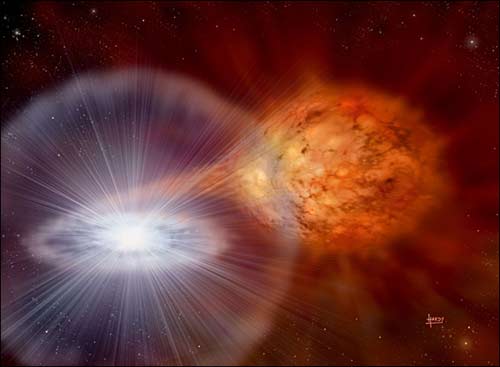Scientists see a star about to explode
International astronomers have just seen an exploding star glowing a lot more than usual, looking extremely beautiful. That star suddenly lit up at the end of last February, after which it became 1000 times brighter than usual.
Scientists say in Nature that RS Ophiuchi is about to be burned in a nuclear explosion called supernova explosion of type 1a. (Supernovae, or supernovae, are some type of stellar explosions that make very bright objects mainly composed of plasma that flares up for a short time and then fades in a few weeks or months.)

Star RS Ophiuchi (Photo: BBC)
This is one of the most glowing explosions in the universe, its light radiating 5 million times brighter than the sun.
They are so bright that we can see them from very far away in the universe.
These explosions also seem to be particularly similar that they always seem to emit the same amount of light and people rely on how much they see from the earth to estimate the size of the Universe. pillars and often explosions just do not see well when their distance is too far from the earth.
But the only problem that made the astronomers so confused was that they had never captured or seen the close-up of a supernova explosion of type 1a - their estimates of the size of the universe were based solely on in theory.
The supernova explosions of type 1a are so rare that the most recent explosion that everyone knows in our galaxy is in 1572. The great Danish astronomer Tycho Brahe observed this explosion. . He was the first person to coined the term nova for the "new star" without even realizing that he was actually witnessing an intense explosion of a star's life.
End of life
It has long been believed that the supernova explosion of type 1a is the death of a white dwarf. But the explosions now happen so far that they cannot see what happened before.
The RS Ophiuchi star in the constellation near the equator Ophiuchus (near the constellation Libra) is actually a kind of white dwarf.
The RS Ophiuchi star has glowed a few times in the last century as if a supernova explosion occurred but failed. It seems that a fusion flame has swept across the surface of the star but not burning.
The last time RS Ophiuchi was bright was in 1985 when astronomers' technology was not high enough to see all the details.
Today, with telescopes and vast radio pan ranges, this has changed completely. The team of astronomers said in the " Nature " journal that they discovered a gas generated by the fires on the star.
The top author of Harvard University's Jeno Sokoloski said in a science program, "The BBC's" Action "section states: " The explosion is so powerful that it can knock out some of the material from the star's surface. into space "

Ms. Jeno Sokoloski (Photo: e-guana.net)
Jeno Sokoloski adds that by studying the gas generated by the star's fire, scientists can learn more about that star.
"And it is almost immediately that the air begins to weaken in just two days and that tells us that this white star is huge (big) enough to collapse into the mind under the pressure of gravity. of itself "
Critical mass.
According to the theory, white dwarfs will be destroyed when their critical mass is equal to 1.4 times the sun.
RS Oph star is on critical mass threshold. It is slowly drawing away the matter from the giant star that circulates around it and every decade it reaches an extra millionth of the critical mass of the sun.
At this point, when at critical mass threshold, why does the RS Oph star turn off the flames on them by themselves?
But in the near future, why RS Oph will pass the threshold and the nuclear fire will explode from deep inside the star and cause the star to explode. But it is not clear when RS Oph will exceed the threshold.
Jeno Sokoloski said "it could be tomorrow, but it could be 1000 years, 10,000 years or even 100,000 years".
And when the explosion happens, it will be a very impressive explosion, very beautiful, it will glow all over the planet so we can see its last beauty in the daytime.
In the meantime, astronomers will closely observe the star to study each of its destructive phases in the hope that it can fully and completely understand one of the mysteries of the universe. .
The star in the constellation near the equator Ophiuchus (near the constellation Libra).
- The star is about to explode 1,400 times larger than the Sun.
- The mystery of giant stars: Do they explode?
- Why does the phone explode while charging?
- Why does the balloon explode?
- The scientists were skeptical of discovering Star Death
- Strange star makes scientists lose sleep
- The mysterious age of the mysterious star
- An oversized supernova image is exploding
- Develop a li-ion battery that alerts itself of gas that is about to explode
- 22 billion years more Earth will explode?
- Planet's 'carnivorous' star is 450 light years from Earth
- Superheated plasma balls emanating from the dying star
 Van Allen's belt and evidence that the Apollo 11 mission to the Moon was myth
Van Allen's belt and evidence that the Apollo 11 mission to the Moon was myth The levels of civilization in the universe (Kardashev scale)
The levels of civilization in the universe (Kardashev scale) Today Mars, the sun and the Earth are aligned
Today Mars, the sun and the Earth are aligned The Amazon owner announced a secret plan to build a space base for thousands of people
The Amazon owner announced a secret plan to build a space base for thousands of people